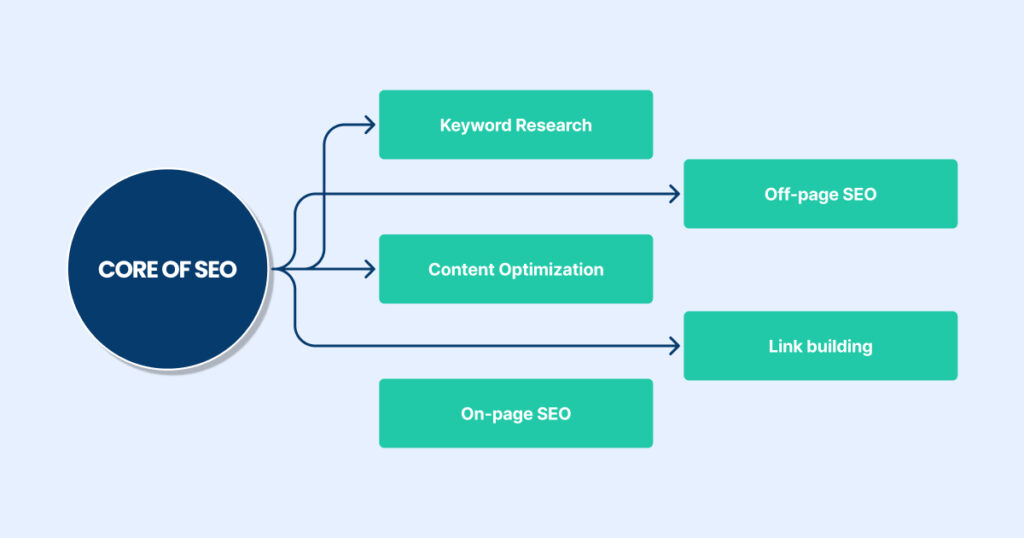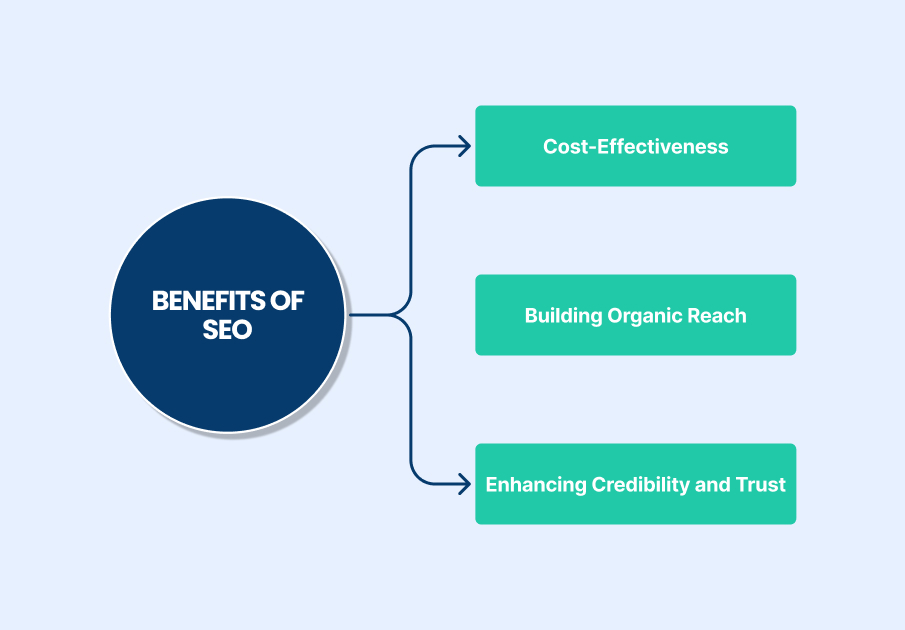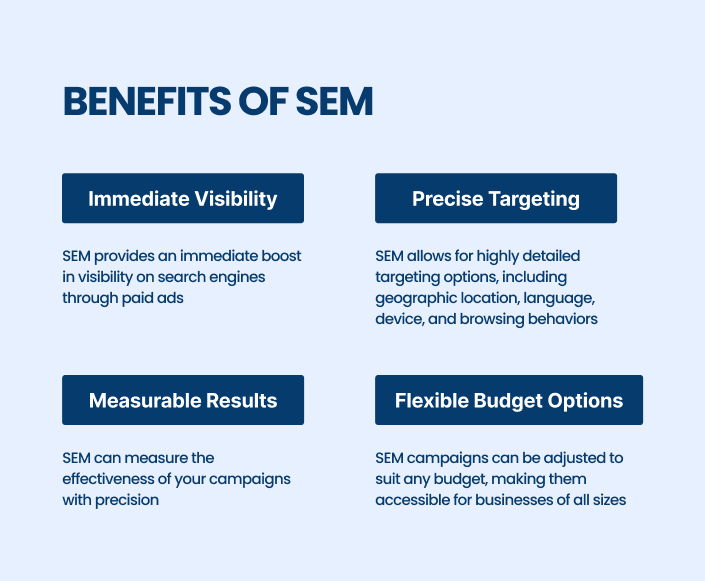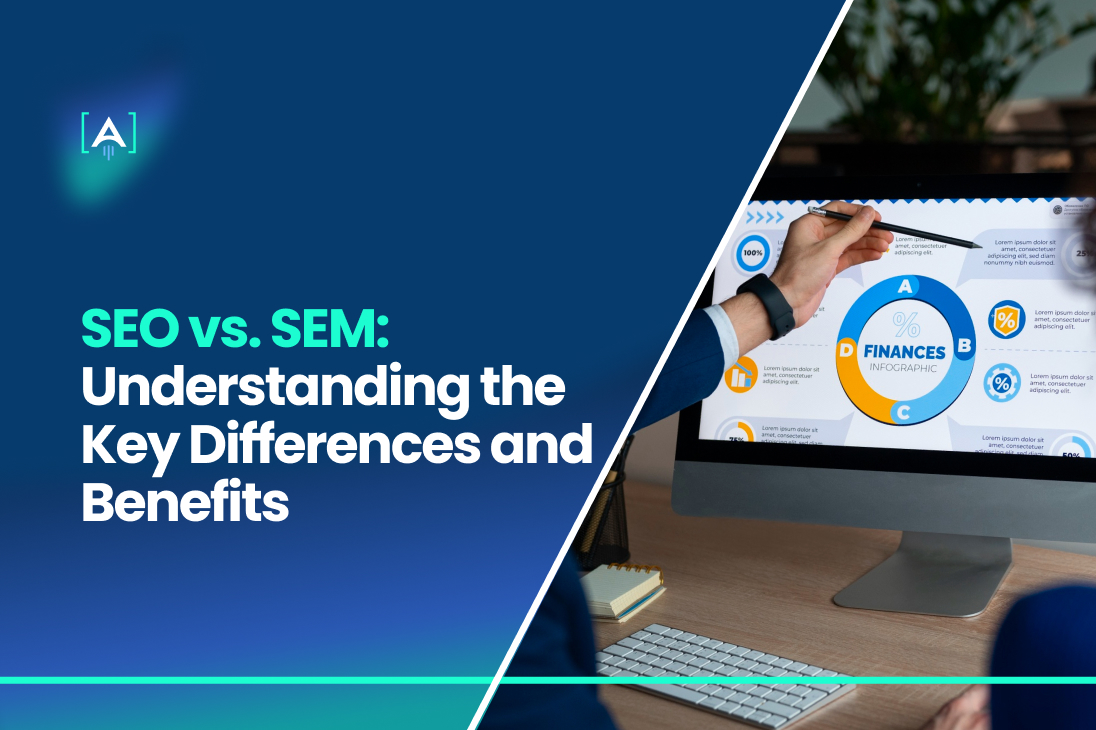Confused about SEO vs. SEM? Not sure where to start with keywords or ads?
Don’t worry—you’re not alone! SEO and SEM are powerful tools for seeing your website online, but they work very differently.
Moreover, it is the right place for any SEO Agency.
SEO and SEM make you stand out from the crowd and naturally draw people in for a conversation and, hopefully, a website visit.
Source: SemRush
The blog post will assist you in understanding the difference between SEO vs. SEM, what sets them apart, and why they matter.
Defining SEO and SEM
What is SEO?
Search Engine Optimization (SEO) is a critical element of digital marketing focused on improving a website’s organic rankings in search engine results pages (SERPs).
The core of SEO revolves around enhancing the quality and volume of traffic to a website within the organic search engine results.

On-page SEO involves optimizing elements within your website, including content, HTML tags, and images, to boost rankings.
The practice of advanced SEO includes more sophisticated techniques like programmatic SEO, where SEO automation is used to scale the SEO efforts, and AI in SEO, which leverages artificial intelligence to predict future SEO trends, personalize content, and improve user experiences.
What is SEM?
Search Engine Marketing (SEM) is a broader term that includes SEO and other marketing tactics that involve paid advertisements to increase a site’s visibility on search engines.
Source: Google
SEM primarily refers to paid components such as pay-per-click (PPC) advertising, where marketers pay for each click on their advertisements. This strategy allows for immediate visibility and targeted advertising, which can be highly beneficial for short-term campaigns or for businesses looking to get quick results from specific audiences.
Comparing the strategies of SEM vs. SEO, SEM often focus on optimizing ad spend and maximizing the return on investment by carefully selecting and bidding on keywords that users will likely use when searching for specific products or services.
Historical Evolution of SEO and SEM: The Early Days of Online Search
Comparing the journey SEO vs. SEM began in the mid-1990s as search engines emerged as essential tools for accessing information on the rapidly expanding web.
Initially, the process was simplistic—search engines like AltaVista and Yahoo! cataloged websites using basic information and site titles. Early SEO practices were primitive, focusing mainly on keyword stuffing and excessive tagging to attract search engine crawlers.
At this time, SEM was also taking shape, with the first paid search ads appearing as simple text-based banners that did not require much sophistication in terms of targeting or keyword usage.
How SEO and SEM Have Adapted to Changing Search Engine Algorithms
As search engines evolved, they developed more complex algorithms to reduce spam and provide users with more relevant search results, prompting significant changes in the strategies of SEO vs. SEM strategies.

Google’s introduction of PageRank in 1998 revolutionized the field by linking search results to the quality and quantity of links to pages. This change required SEO professionals to adopt more refined techniques, focusing on the quality of content and backlinks rather than merely stuffing pages with keywords.
Core Differences Between SEO and SEM
Understanding the essential differences between Search Engine Optimization (SEO) and Search Engine Marketing (SEM) is crucial for any digital marketer aiming to maximize their online visibility and engagement.
Though both strategies aim to increase a website’s presence in search engine results, they differ significantly in their approach, methodology, and end goals.
Primary Goals and Objectives: The Strategic Focus of SEO
In the debate of SEM vs. SEO, it’s important to note that SEO is focused on optimizing a website to earn higher web traffic levels and improve the site’s visibility in organic search results. Its strategic focus revolves around enhancing the website’s authority and relevance to specific keywords without direct payment to search engines.
Source: Forbes
This process involves a long-term commitment to content quality, site architecture, and many other factors influencing Google’s algorithm, particularly its EEAT Google (Expertise, Authoritativeness, Trustworthiness, and Experience) guidelines.
SEO aims to build a solid foundation to drive traffic over time by deeply understanding audience needs and search engine behaviors.
The ultimate goal is to establish the website as a credible source of information, thereby naturally attracting visitors who are searching for related topics.
The Strategic Focus of SEM
In comparison SEO vs. SEM, the recent focuses on gaining traffic and visibility from organic and paid searches. Its core is much broader and includes SEO as one of its tactics, but it relies heavily on paid advertising methods such as pay-per-click (PPC) campaigns, Google Ads, and other forms of online paid promotions.

The strategic focus of SEM is to increase visibility and immediate traffic flow using targeted advertising quickly. These campaigns are designed to place ads in front of potential customers who are actively searching for related products or services, ensuring that the ads are immediately visible to a targeted audience.
In the context of SEM vs. SEO, SEM strategies are particularly effective for businesses looking to quickly establish a significant market presence or in highly competitive markets.
Techniques in SEO: On-Page and Off-Page
SEO strategy can be broadly categorized into two types: on-page SEO and off-page SEO.
On-page SEO refers to the approaches used directly within the website to improve its position in the search rankings. This includes optimizing the content or the HTML source code of a page.
Source: Ahrefs
Key on-page techniques include using relevant and well-researched keywords in the content, optimizing meta tags and descriptions, and ensuring the website’s search-engine-friendly architecture. It also involves creating high-quality, relevant content that is structured well with headers and subheaders to improve user engagement and retention.
Off-page SEO involves external factors that impact the website’s reputation and authority by improving the perception of a site’s popularity, relevance, trustworthiness, and authority. This is achieved through other reputable places on the Internet (pages, sites, people, etc.) linking to or promoting your website, effectively “vouching” for the quality of your content.
Methods include building high quality backlinks from other reputable websites, engaging on social media platforms, and influencer marketing, which can all drive traffic back to the website.
Techniques in SEM: PPC and Paid Inclusions
SEM techniques primarily revolve around paid search strategies.
Pay-per-click (PPC) advertising is the cornerstone of SEM, where advertisers only pay when users click on their ad. These ads are typically tied to specific keywords, and extensive keyword research is essential to ensure the ads appear for the right search terms.
Campaigns must be carefully crafted, targeting specific demographics, geographic locations, and times of day to optimize the results.
Source: WebFX
Paid inclusions involve paying a fee to include the website in the search engine’s directory. While not as common today as in the early days of search marketing, paid inclusions can still be part of a broader SEM strategy, particularly for niche or highly specialized markets.
If we compare SEO vs. SEM, SEM requires meticulous planning, a deep understanding of search engine algorithms, and continuous optimization to respond to changing online behaviors and algorithm updates.
However, by combining these strategies effectively, businesses can enhance their online visibility, engage with a broader audience, and achieve substantial growth in highly competitive digital landscapes.
Benefits of SEO
Search Engine Optimization (SEO) offers numerous advantages for businesses searching for establish a strong online presence without the continuous financial commitment required by SEM strategies.
From enhancing site visibility to building brand credibility, SEO’s benefits are substantial and can drive long-term success.
Cost-Effectiveness: Long-Term Cost Benefits of SEO
In the discussion of SEM vs. SEO, one of the most significant advantages of SEO over SEM is its cost-effectiveness. While SEM requires ongoing funding to keep the ads running, SEO provides sustainable visibility without the perpetual cost.
Initial investments in SEO might involve optimizing website content, improving site structure, and building backlinks, but these efforts yield enduring benefits. For example, a well-optimized page can maintain its rank and continue to attract traffic for years without additional spending. In the debate of SEM vs. SEO, it’s clear that over time, SEO becomes less costly than SEM, where visibility stops as soon as the advertising budget is paused.
Methods like Google Keyword Planner can help refine SEO strategies, allowing businesses to target keywords efficiently, which leads to better budget allocation and higher ROI.
Moreover, technical SEO improvements, such as enhancing site speed and mobile compatibility, supporting SEO goals, and improving the overall user experience, contribute to higher conversion rates without ongoing expenses.
Building Organic Reach: The Importance of Organic Traffic
Organic reach refers to the number of elements who find your website using search engines without being influenced by paid advertising. The importance of organic traffic cannot be overstated—it is often the core source of website traffic and is considered highly valuable due to the intent behind search queries.
Users who find your website through organic search are typically looking for something specific, which means they are closer to the point of action, be it a purchase, sign-up, or another form of conversion.
Organic traffic is also more stable and reliable in the long term. In the comparison of SEM vs. SEO, it’s evident that unlike SEM, where traffic is contingent on continuous investment, organic reach builds and maintains itself once effective SEO strategies are implemented.
As you optimize content and your site adheres more closely to a search engine’s algorithm, the trust these organic visitors have in your site increases, leading to better engagement and conversion rates.
Enhancing Credibility and Trust: How SEO Builds Brand Authority
SEO significantly enhances a brand’s credibility and authority in its industry. Search engines such as Google use complex algorithms to rank websites and high rankings are often seen as endorsements by the search engine.
When your website ranks high for key terms, it signals to users that it is a reliable source of information, products, or services. This perceived endorsement increases user trust, which is crucial in the digital marketplace.
Moreover, SEO efforts often involve creating high-quality content that addresses user needs and questions. This helps you rank and establish your brand as an expert in your field. Consistently creating valuable content can lead to other reputable websites linking back to your site, further enhancing its authority and potential customers’ trust in your brand.
In addition to the direct pros of increased traffic and conversions, this trust and authority can have secondary effects, such as increased brand loyalty and customer retention. Unlike SEM, which pushes a brand in front of consumers, SEO pulls consumers towards the brand, fostering a natural relationship based on trust and credibility.
Benefits of SEM
Search Engine Marketing (SEM) is a powerful digital marketing strategy that complements SEO efforts by offering immediate visibility and targeted reach.

While SEO focuses on organic growth over time, SEM harnesses the power of paid ads to ensure quick results and precise targeting.
This approach is particularly advantageous in competitive industries or businesses looking to enter a rapid market.
Targeting and Customization: Advanced Targeting Options in SEM
One of the most significant advantages of SEM is its capability for advanced targeting.
Unlike traditional advertising methods, SEM allows businesses to pinpoint their audience accurately. This is achieved through various targeting options, including geographic location, language, demographic data, browsing behavior, and even specific devices, making it particularly effective for mobile SEO strategies.
This level of customization is critical in international SEO, where ads can be tailored to fit cultural nuances and local search trends in different regions.
Additionally, SEM platforms like Google Ads offer retargeting options, which allow businesses to display ads to users who have previously applied to their website but did not convert, thereby increasing the chances of conversion upon return.
In the realm of a Search Generative Engine (SGE), which optimizes the generation and retrieval of web content, SEM’s targeted capabilities can be leveraged to ensure that the most relevant and customized content reaches the right audience.
Measurable and Scalable: How SEM Provides Clear ROI Metrics
SEM’s effectiveness is not only evident in its targeting capabilities but also in its measurability and scalability. Every aspect of an SEM campaign can be tracked and analyzed, from the number of impressions and clicks to more detailed conversions and sales data.
Tools integrated within SEM platforms, like Google Ads, provide comprehensive dashboards that offer insights into the performance of each campaign, keyword, or ad group.
These metrics are essential for calculating SEM campaigns’ return on investment (ROI). Businesses can see exactly how much they are using and what they are earning in return, allowing them to adjust their bids, budgets, and ad strategies in real-time to optimize spending.
This level of detail supports white hat SEO practices by ensuring that efforts are effective, ethical, and aligned with search engine guidelines.
Moreover, SEM’s scalability is a key benefit. Campaigns can be adjusted according to budget allowances or business growth objectives. Whether a company wants to test the waters with a small budget or scale a successful campaign to maximize returns, SEM provides the flexibility needed to expand efforts without requiring extensive backend changes.
Quick Market Entry: Benefits for New Businesses and Products
For new businesses or those launching new products, SEM offers an unparalleled advantage: quick market entry.
Unlike SEO, which can take months to provide significant results, SEM can immediately place your brand at the top of SERP features. This rapid visibility is crucial for new businesses that must establish a market presence and generate revenue quickly.
SEM’s fast-paced nature helps new businesses build awareness and capture market share in the crowded digital space. By appearing in prominent positions on SERPs, startups and new products gain credibility and attract early adopters, even in markets dominated by established brands.
Furthermore, integrating technical SEO into the website’s foundation ensures that once SEM attracts visitors, it is optimized to convert them efficiently.
Partner with [A] Growth Agency for Identifying Your SEO and SEM Strategies
By understanding the power of SEO vs. SEM, you’ve revealed the secrets to online success.
Whether you choose organic search optimization or paid advertising or leverage both strategically, you’re now equipped to boost your target audience and achieve your website’s goals.
[A] Growth Agency can be the right partner. We treat every business as a unique entity. Our strategies are tailor-made, and we’re not afraid to experiment to find the best path forward. Moreover, Excellence is our standard. The most important is that we cultivate a team of ‘A players’ – top-tier talents who bring passion and expertise to every challenge.
Ready to move beyond the SEO vs. SEM confusion and create a successful online presence?

